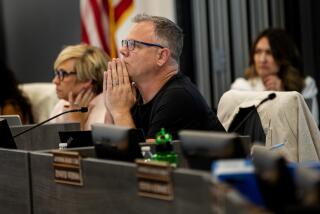Black History Lessons Flunk Test, Critics Say : Schools: Parents and teachers argue that without requirements, the subject often is ignored.
Regina Ford doesnât like the idea that her 15-year-old son, Milan, doesnât know that black Americans invented the gas mask, the traffic signal or the recipe for Coke.
Nor is she pleased that her daughterâs history books donât teach that Dr. Charles R. Drew, a black American, invented a method to store blood or that Phillis Wheatley was the second woman in this country to publish a book.
As a black parent with children in the Orange County public school system, Ford says that she, like others, thinks the schools are doing an inadequate job of teaching all students the many accomplishments of black Americans.
âThere is so much more to black history than the fact that we were brought over here as slaves,â Ford said. âBut from reading the kidsâ history books, youâd never know it. It is as though time stopped for blacks while we were on the plantation.â
What is taught in Orange County about black history ranges from textbook lessons about slavery, at Huntington Beach High School, for instance, to various assemblies, games and programs about black history at Tustin High School and Santa Ana High School.
This month, nationally recognized as Black History Month, county administrators said they recognize the importance of teaching the history of every culture. But they stressed that the amount and content of history taught is left to individual teachers.
âWhat is taught differs from district, school to school and teacher to teacher,â said Don Carlos of the Garden Grove Unified School District. âThere is no uniform system. And though there are certain aspects of black history in most textbooks, how much itâs used and how far itâs taken is up to the instructor.â In fact, the state of California does not mandate that any black history be taught in the classroom.
âWe make recommendations on the type of instructions that can be given concerning different cultures, but it isnât mandatory,â said William Rukeyser of the California Department of Education. âCalifornia is not like New York, where the state board monitors and controls what each school district does. We allow the districts to do what they feel is best.â
But black instructors in the county argue that without some type of requirement, the subject often is ignored by schools that have a small black enrollment and few black teachers.
âIâve been teaching for more than 19 years in Orange County, and itâs been my experience that if the black teachers on staff donât go out of their way to make sure black history information is up and stressed, particularly during black history month, it doesnât get done,â said Judy Sampson, eighth-grade teacher at Sierra Intermediate School in Santa Ana, whose classroom is decorated year-round with posters depicting black history.
âI just happen to be in a school where the principal encourages me to teach black history because the textbooks certainly donât do that great of a job,â Sampson said. âBut that is not the case the large majority of the time.â
Each year during black history month, Sampson organizes assemblies, plays and trivia games for Sierra Intermediate School in Santa Ana.
âAll the kids, particularly at a younger age, are very receptive and interested in black accomplishments. And this is important because it teaches all cultures how important we have been to this country,â Sampson said. âWhich down the road will help them avoid believing many of the negative stereotypes this county has a way of making people believe about the black race.â
At Tustin and Capistrano Valley high schools, black students themselves pushed for recognition of their heritage.
âFor black history month, the black students really wanted the school to get an education on black history, so they took it upon themselves to get it done and came to me with the ideas,â said Shawn Wirth, activities director at Capistrano Valley. âThey put up posters, set up displays and even had video tapes on black events play during lunch.â
At Tustin High School, black students formed an African-American Culture club, which studies the works of black authors, artists and inventors.
But at Huntington Beach High School, which has no black teachers or administrators and only about 20 black students among more than 2,000, little is taught about black history, except for the textbook descriptions of slavery. It is far from alone in the county.
âTo my knowledge weâve done nothing for black history month in particular at the school,â said Leon Stoab, assistant principal. âAnd as far as course instruction, the history books we use donât do a really thorough job of describing black life after 1900. But we are hoping that will change with the new state approved and updated texts coming out next year.â
In recent years, the state, which oversees new textbooks, has made sure that more black history was included in the social studies and history books.
âIn 1987 we began expanding our coverage of all cultures in our history and social studies texts,â Rukeyser said. âIn those books and other new texts weâve adopted for next year, there is a large section on human rights and in particular the violation of human rights with reference to slavery. We hope to make even more changes in the future because we realize that California has a great many different cultures that all need to be understood.â But Regina Ford doesnât think that change is happening fast enough. Having attended public school in Orange County during the â60s, Ford says she sees little difference from what was taught then.
âI attended Santa Ana High School and was basically only given information on the fact that we were slaves,â she said. âThe only difference now is that they might, depending on what school it is and where in Orange County itâs located, tell the kids about Dr. Martin Luther King Jr.â
Ford says she remembers when officials at her daughterâs school in Anaheim said they werenât going to tell the children why a holiday was named for King because he was controversial.
âWhen my daughter told me that they hadnât mentioned once why students would be out for that day, I was outraged and made an appointment to speak with the principal,â Ford said. The principal âtold me that Dr. King had too many negatives about him to be used as a role model for kids. It didnât seem to matter that John F. Kennedy was also supposedly a womanizer, yet he remains in the books.â
While some schools base the amount of black history taught on the number of black students, others, such as Monte Vista Elementary School in Santa Ana, give considerable attention to it, despite small black enrollments.
âBeing that the school is in the inner city, we wouldnât be doing our jobs if we didnât try to teach the kids about the different backgrounds of people,â said Donald Tibbetts, principal of Monte Vista, which has only 26 black students. âWe think this is imperative to the childrenâs growth, and they see the differences in the classroom everyday. Itâs our job to help them understand.â
The schoolâs library is filled with information about black history and decorated with posters on the subject. And every year on Kingâs birthday, every class in the school makes a cake.
But Howard Booker, a black teacher at Mountain View High School in Santa Ana, said schools like Monte Vista are the exception.
During the early 1970s, he said, there âseemed to be a bigger push for black history studies by the district. I even taught a black literature class at Valley High School that white students wanted to enroll in,â Booker said. The âfocus has changed, so now I just try to teach black history on my own.â
Booker makes his own tests, quizzes and fact sheets about U.S. history with information rarely featured in history books.
Thomas Parham, director of the career planning and placement center at UC Irvine, would have more teachers like Booker.
âTodayâs black youngsters need to know that their ancestors were strong, successful and powerful people who helped build this nation,â Parham said. âSo many young blacks donât realize who they are or where they come. All they see, just as others, are the arrests and drug bust on nightly news. Can you imagine what that does for their self-esteem? It certainly doesnât motivate them to stay in school and continue to do well. They need to learn that blacks are survivors, inventors and creators. What better place is there for them to learn that than in the classroom?â
Excerpts From an Untitled Poem
When I walk in a classroom
I expect to learn.
I really donât care to hear
My people get burned . . .
They teach of good olâ Huckleberry Finn,
And dumb little, uneducated Jim . . .
Iâm sick and tired of hearing
My people get burned.
When I walk in a classroom,
I expect to learn . . .
Iâm learning more of my history
Through rap and rhyme
Than I have in a classroom
In one yearâs time.
Donât tell me to be patient,
Donât tell me to wait.
--DIEDRA BARBER, 17, Tustin High School
A Black History Quiz
1. What black doctor bled to death in 1950 after he was injured in a car crash and was refused admission to a whites-only hospital?
2. What former slave returned to the South 19 times to rescue more than 300 other slaves?
3. What black scientist discovered more than 300 products that could be produced from the peanut, including peanut butter, ink, soap and instant coffee?
4. Whose blood still stains the wall of a Harlem ballroom, where some of the 21 bullets fired at him also remain?
5. Who performed the first open-heart surgery in 1893?
6. What black scientist published 10 almanacs and helped design buildings and streets for the city that would become Washington, D.C.?
7. What diplomat was the first black American to win the Nobel Peace Prize in 1950 for successfully ending the first Arab-Israeli war?
8. Black scientist Percy L. Julian discovered the cure for what blinding disease?
9. Who invented the traffic signal in 1913 and the gas mask in 1914?
10. Who was the first black female elected to the U.S. House of Representatives and the first woman to run for the presidency?
Answers, B9
HISTORY ANSWERS
Answers to questions on B7.
1. Dr. Charles R. Drew, whose invention for blood storage made blood transfusions possible.
2. Harriet Tubman.
3. George Washington Carver.
4. Malcolm X.
5. Dr. Daniel Hale Williams.
6. Benjamin Banneker.
7. Ralph Bunche.
8. Glaucoma.
9. Garret A. Morgan.
10. Shirley Chisholm.
More to Read
Sign up for Essential California
The most important California stories and recommendations in your inbox every morning.
You may occasionally receive promotional content from the Los Angeles Times.










